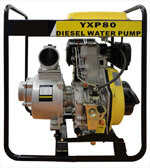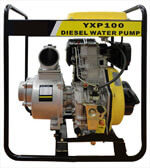Diesel Water Pumps
If diesel is your fuel of choice and/or readily available, look into these strong running semi trash water pumps. All pumps have silicon carbide mechanical seals that resist corrosion, wear better and heat better than a standard seal. The long lasting high end silicon carbide seal are suited for heavy duty applications such as pumping contaminated and abrasive fluids. The cast iron impeller and volute will reduce vibration and wear on the mechanical seal and engine, allowing them to last longer for semi trash operations.
All diesel water pump units are ideal for industrial application or agricultural applications. There are specific terms that relate to this type of equipment. The more critical terms when identifying the right pump for you are GPM rate, Lift and Maximum Head. Pump performance is measured in volume (GPM) and in pressure (HEAD). In general the trade off occurs between head and flow with an increase in causing a decrease in flow and vice versa. Head refers to gains or losses in pressure caused by gravity and friction as water moves through the system. For example, the length of the hose and the elevation could affect your performance directly. The lift is the vertical distance from the water line to the centerline of the impeller. Other factors that can diminish performance are temperature and altitude. Warm water as a result will decrease lift. For general dewatering needs where high abrasives or solids may exist, these semi trash pumps are a great choice. Low maintenance combined with reliable diesel engines will ensure a steady operation.
Excellent fuel consumption: average operating time for single tank of fuel: 12 hours Auto-return decompression for efficient starting at all temperature conditions Easy-cleanout, durable aluminum.
Diesel Driven Water Pumps
3" Diesel Water Pump
- Engine: 6 HP Diesel
- Starting System: Electric Start
- Maximum Capacity: 220 GPM
- Maximum Head: 42 feet
- Size: 3 x 3 Inch Suction and Discharge
- Lift: Up to 26 feet
- Fuel Tank Capacity: 1 Gallon
- Weight: 115 lbs
- Dimensions: 23”L x 20”W x 27”H
- Warranty: 1 Year Engine Warranty
![]() Operations Manual (11,1 MB)
Operations Manual (11,1 MB)
4" Diesel Water Pump
- Engine: 10 HP Diesel
- Starting System: Electric Start
- Maximum Capacity: 422 GPM
- Maximum Head: 52 feet
- Size: 4 x 4 Inch Suction and Discharge
- Lift: Up to 26 feet
- Fuel Tank Capacity: 1.5 Gallon
- Weight: 115 lbs
- Dimensions: 23”L x 20”W x 27”H
- Warranty: 1 Year Engine Warranty
![]() Operations Manual (11,1 MB)
Operations Manual (11,1 MB)
Diesel Water Pump Terminology
| Head | Refers to the height of a column of water that can be supported by the pressure or vacuum exerted at the pump. |
| Static Suction Head | The vertical distance between the pump impeller and the surface of the liquid on the suction side of the pump. |
| Dynamic Suction Head | The static suction head plus the additional suction head created by friction from the liquid flowing through the hoses, fittings, etc. Atmospheric pressure enables pumps to lift water. As a result, an atmospheric pressure of 14.7 psi at sea level limits practical dynamic suction head lift to less than approximately 26 feet for any pump. |
| Static Discharge Head | The vertical distance between the pump's discharge port and the point of discharge, which is the liquid surface if the hose is submerged or pumping into the bottom of a tank. |
| Dynamic Discharge Head | The static discharge head plus the additional discharge head created by friction or resistance (usually referred to as losses) from the liquid flowing through the hoses, fittings, sprinklers, nozzle, etc. |
| Total Head | The dynamic suction head plus the dynamic discharge head. |
| Pressure | Pressure is force per unit area and is usually listed in psi (pounds per square inch). Pressure is often included in pump performance curves. Pressure and head are directly related when referring to pump performance. The pressure exerted (in psi) at the base of a column of water is 0.433 x Head (in feet). If you attach pressure gauge at the base of a pipe 100 feet tall pipe filled with clear water, you would measure 43.3 psi. Notice how the diameter of the pipe doesn't affect the pressure value. The maximum pressure (at zero discharge) of any pump can be determined by multiplying the maximum head by 0.433. |
| Friction Losses | The additional pressure or head created at the pump due to the friction of the liquid flowing through the hoses, pipes, fittings, etc. Friction losses always occur when a liquid is flowing through pipes and becomes greater as the length of pipe increases and/or the diameter decreases. Friction losses result in reduced pump output and can be minimized by used the largest and shortest hoses possible. Friction losses are included in dynamic suction and dynamic discharge head. |
| Impeller | An impeller is a rotating disk containing vanes coupled to the engine's crankshaft. All centrifugal pumps contain an impeller. The impeller vanes sling liquid outward through centrifugal force, causing a pressure change. This pressure change results in liquid flowing through the pump. |
| Volute | The volute is the stationary housing enclosing the impeller. The volute collects and directs the flow of liquid from the impeller and increases the pressure of the high velocity water flowing from the vanes of the impeller. |
| Self-Priming | Most centrifugal pumps require the pump casing to be filled with water before starting. Self-priming is a term often used to describe pumps that have the ability to purge air from the case and create a partial vacuum, allowing water begin flowing through the suction hose. All Honda pumps are defined as self-priming. |
| Mechanical seal | This is a spring-loaded seal consisting of several parts that seals the rotating impeller in the pump case and prevents water from leaking into and damaging the engine. Mechanical seals are subject to wear when pumping water containing abrasives and will quickly overheat if the pump is run without filling the pump chamber with water before starting the engine. Honda trash pumps contain silicone carbide mechanical seals, designed to withstand abrasive conditions. |
| Cavitation | The sudden formation and collapse of low-pressure vapor (bubbles) across the vanes of the impeller. When the surface pressure on a liquid becomes low enough, the liquid will begin to boil (even at room temperature). With centrifugal pumps, cavitation can occur when the suction vacuum becomes to great enough to allow water vapor or bubbles to begin forming at the impeller. When this water vapor travels through the rapid pressure increase across the impeller, a large amount of energy is released which can cause impeller damage. Minimizing suction head and using the largest practical suction hose diameter will reduce the likelihood of cavitation. You should never use a suction hose with a diameter smaller than the pump's suction port. |
|
Can this page be improved? Is the information complete and easy to understand? We are always looking to improve our website, so please feel free to give us your comments or suggestions. Thanks for helping us serve you better! |
















